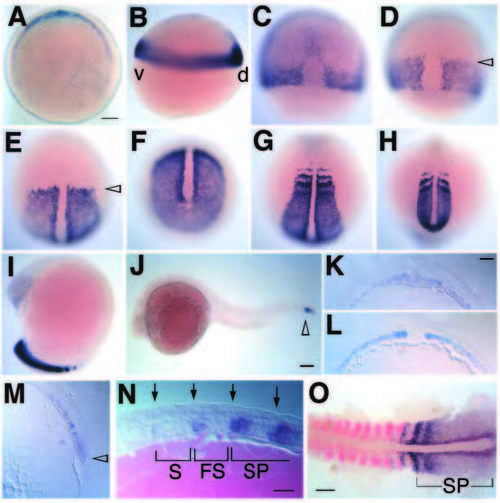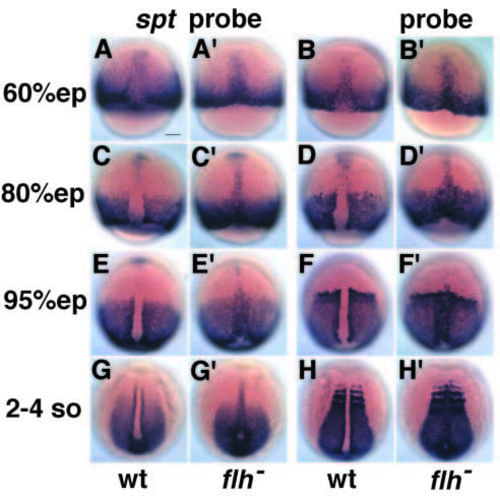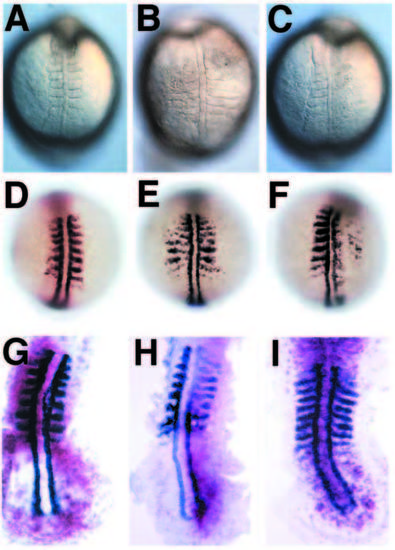- Title
-
Zebrafish paraxial protocadherin is a downstream target of spadetail involved in morphogenesis of gastrula mesoderm
- Authors
- Yamamoto, A., Amacher, S.L., Kim, S.-H., Geissert, D., Kimmel, C.B., and De Robertis, E.M.
- Source
- Full text @ Development
|
papc expression in wild-type embryos. (A) Animal pole view at 30-40% epiboly stage (5 hours), showing dorsal expression of papc (blue) overlapping with that of goosecoid (which is weakly stained in aquamarine color) at the top of the panel. (B) Lateral view at early gastrula (shield stage, 6 hours); papc is detected in the entire marginal zone. d, dorsal; v, ventral. (C) 60% epiboly stage (7 hours); papc transcripts decrease in the dorsal midline. A weak papc signal is also seen in presumptive head mesendoderm. (D) 70-75% epiboly stage (8 hours); papc expression domain is broader along the animal-vegetal axis (anterior edge indicated by arrowhead); expression in the dorsal midline is undetectable. (E) At the end of gastrulation (bud stage, 10 hours), the anterior and mediolateral borders of papc expression become sharp. The arrowhead marks the anterior border of papc expression. (F) Bud stage, posterior view, the mesoderm ventral to the blastopore is positive for papc RNA. Signals are strongest next to the midline, where the adaxial cell population is located. (G) Dorsal view at 3-somite stage showing papc expression in paraxial mesoderm and anterior segmental bands. (H) Posterior and (I) lateral view at 14-somite stage; papc transcripts are detected in tail presomitic mesoderm. (J) Lateral view of a 24 hour embryo. Expression is detected only in the tip of the tail (arrowhead). (K-N) Sections of embryos hybridized in whole mount. (K) Section through the blastoderm margin at shield stage; expression is restricted to the involuting mesoderm and spans the midline. (L) Transverse section at bud stage (10 hours) showing papc expression in paraxial, but not axial, mesoderm. (M) Parasagittal section of the dorsal side of a late shield-stage embryo. Signal is detected in involuted and involuting hypoblast and the surface epiblast of the blastopore (arrowhead) in the marginal zone. (N) Parasagittal section at the 4-somite stage. The four bands of papc expression are indicated by arrows; weak expression is detectable at the anterior edge of the last formed (S) and forming somite (FS); the two strong bands are located in the segmental plate (SP). Anterior is to the left. (O) Double staining with myoDM (red) and papc (blue) at 8-9 somite stage. Expression of the two genes overlaps in the last formed and the forming somite but not in the segmental plate (SP). Embryo was deyolked manually and flattened. Maternal transcripts were detectable by in situ hybridization at early cleavage stages (data not shown). Bars, 100 mm (A; also applies to B-I); 50 μm (K-M); 25 μm (N); 100 μm (O). EXPRESSION / LABELING:
|
|
papc expression is defective in spt mutant embryos. (A-E) Wild-type embryos. (A′-E′) sptb104 homozygous mutant embryos. (A,A′) Shield stage showing greatly reduced papc in spt- embryos at the onset of gastrulation. (B,B′) 80% epiboly showing lack of papc expression in the marginal zone of the spt mutant. (C,C′) Bud (10 hour) stage, (D,D′) 4-6 somite stage; expression is detected only in a few adaxial-like cells in spt mutants. (E,E′) 18 somite stage; the expression of papc recovers in tail somites, in the segmental plate and in the tailbud of spt mutants. A-D and A′-D′ are dorsal views, E and E′ are posterior views. Bars in A (also applies to B-D) and E, 100 μm. EXPRESSION / LABELING:
|
|
spt and papc are expressed ectopically in the midline of flh mutant embryos. Probes and embryo genotypes used are shown at the top and the bottom of the figure, respectively. The stage is indicated on the left; ep, epiboly; so, somite. The spt expression pattern in wild-type embryos is very similar to that of papc except that the anterior border of expression differs at early somite stages. In addition, in the case of papc, the anterior border is segmented. In flh mutant embryos, expression of spt and papc is not excluded from the midline, even in the somite stage. Bar, 100 μm. EXPRESSION / LABELING:
|
|
Dominant-negative papc inhibits convergence movements of paraxial mesoderm. (A) Control embryo injected with lacZ mRNA. (B) Embryo with widened somites caused by injection of DN-papc mRNA. (C) Embryo injected with DN-papc showing unilateral lack of trunk somites. (D) Embryo injected with FL-papc mRNA (100 pg) and stained with myoD probe; somites and the adaxial muscle cells flanking the notochord are normal. (E) DN-papc mRNA injection causes lateral expansion of myoD expression; axial mesoderm is normal. (F) Reduction of myoD expression caused by DN-papc injection, a few myoD-positive cells are seen in lateral positions but not in the paraxial region. (G) Embryo injected with lacZ mRNA. lacZ is in red and myoD in blue. Somites are normal and lacZ activity is seen on both sides. (H) Widened somites on the injected side of embryo injected with DN-papc mRNA. (I) Embryo that received mRNA bilaterally showing expanded somites on both sides. The amount of mRNA injected was 50 pg for DN-papc and 500 pg for lacZ in all cases. |




